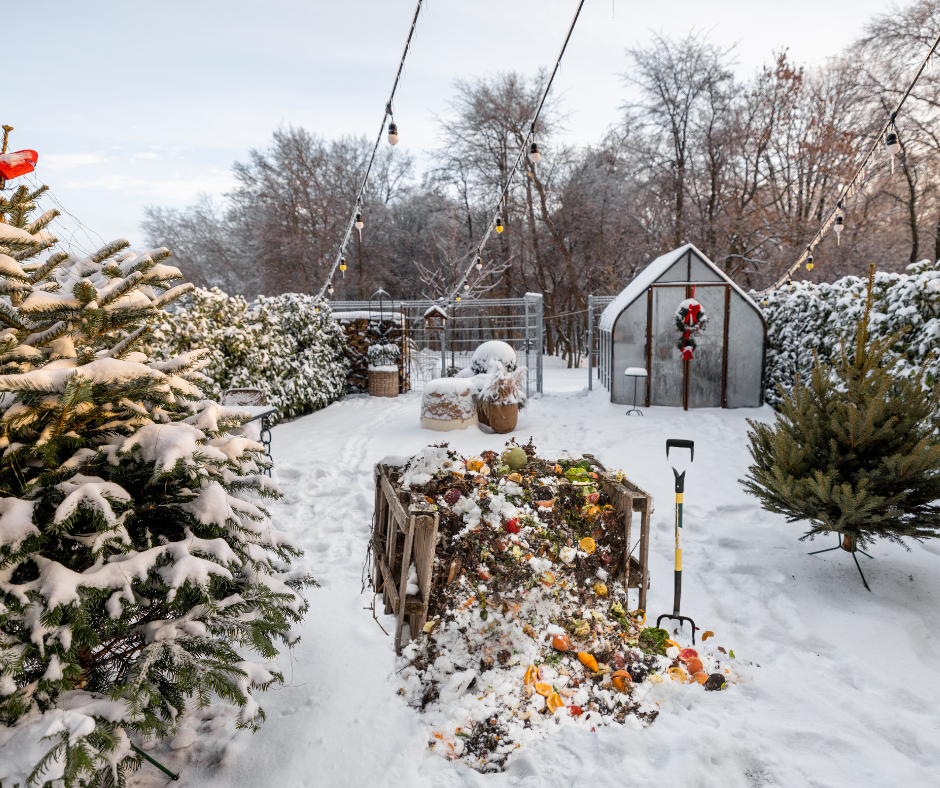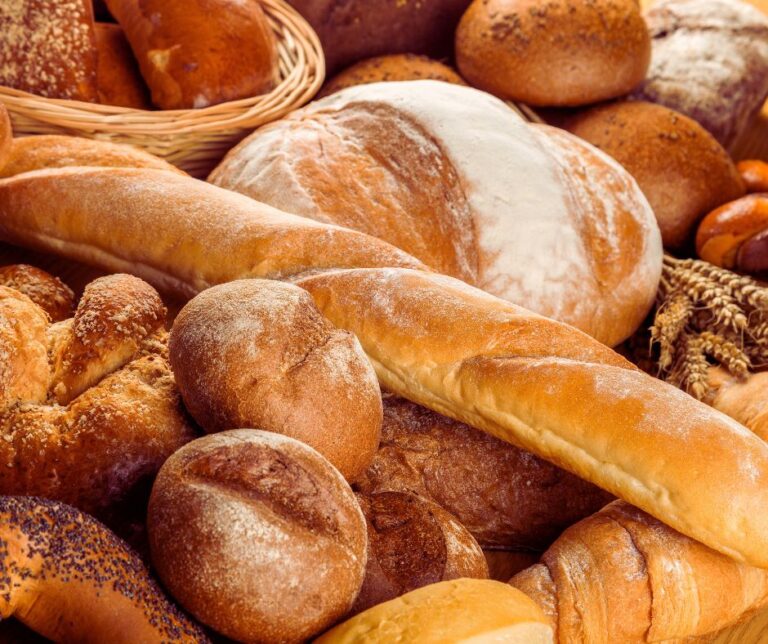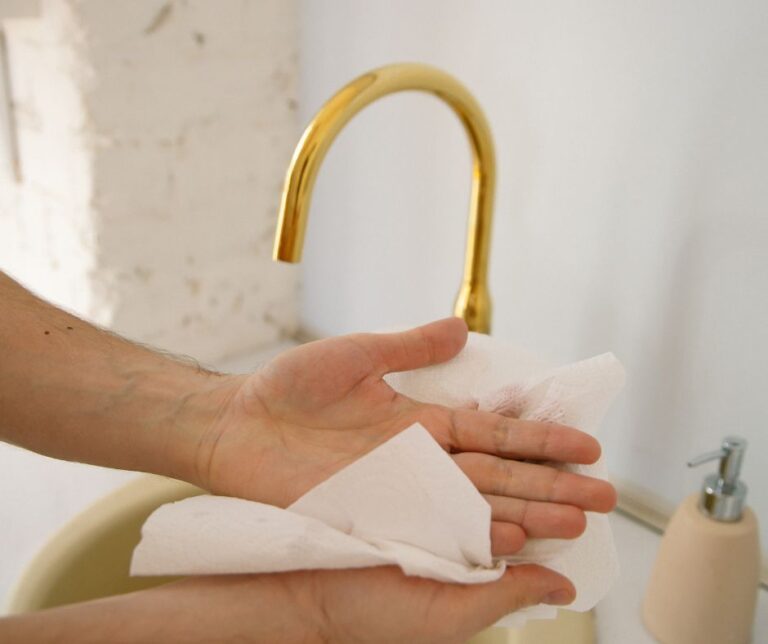Can You Compost in Winter? Yes, Here’s How to Master Cold-Weather Composting!
Can you compost in winter? Absolutely. This piece delves into the how-tos of cold-weather composting, giving you a blueprint for successful decomposition despite the chill. Without overwhelming detail, expect to discover vital tweaks for your composting routine that cater to the season’s challenges.
Key Takeaways
Winter Composting Essentials
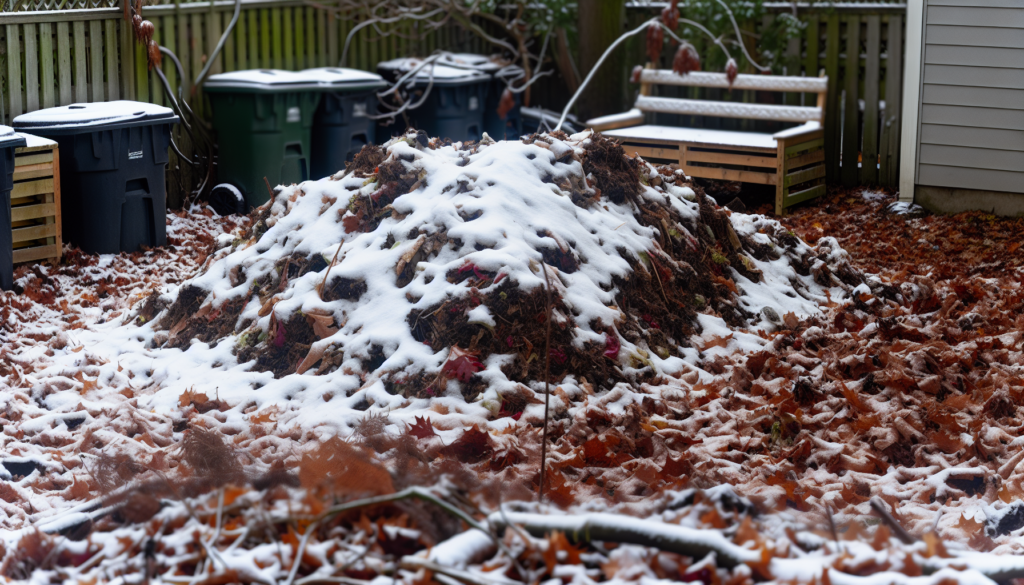
Composting during winter is not only possible but also practical. With careful preparation, you can maintain decomposition in your compost bins and piles even during the colder months, helping you reduce household waste and produce valuable soil amendments. Think about it. Continuing composting through winter ensures a ready supply of compost for your spring garden preparation.
But how exactly does one go about composting in winter? Well, it all starts with selecting the right location for your composting in the winter, compost bin, choosing suitable materials for your winter pile, and effectively managing moisture and insulation. We will further explore these essentials.
The Right Location for Your Winter Compost Bin
It’s vital to pick the correct location for your winter compost piles or bin. The ideal spot is one that receives plenty of sunlight and is sheltered from high winds to protect the pile from freezing temperatures. Moving your winter compost piles or bin to a sunnier part of your yard, preferably facing a southern direction, can help keep the pile warmer by maximizing sunlight exposure.
But that’s not all. The spot you choose should also be conveniently close to the back door your house. This way, you can easily add scraps to your compost pile without having to trudge through the snow. So, keep these factors in mind when deciding where to position your winter compost bin.
Selecting Suitable Materials for Your Winter Pile
After determining the location of compost bins, consider the materials for your traditional compost pile. Stockpiling brown materials like leaves plant debris, pine needles, straw, sawdust, woodchips, and shredded newspaper is essential for creating traditional compost piles.
in the fall it is crucial for maintaining a balanced compost pile throughout winter. Shredded paper, for instance, provides the necessary carbon to balance the high nitrogen content of food scraps.
Remember to include the greens as compost pieces well. Kitchen scraps commonly produced in winter are considered ‘greens’ and have a carbon-to-nitrogen ratio typically between 15 to 20. Adding nitrogen-rich ingredients like coffee grounds to your compost pile provides resources for bacteria and helps speed up decomposition.
Keep in mind, to avoid a wet and smelly compost pile by spring, balance is vital when layering or mixing greens with browns. The ideal carbon-to-nitrogen ratio for a winter compost pile is about 30-to-1 to ensure effective composting without odor or decomposition issues.
Managing Moisture and Insulation
Another vital part of winter composting is managing moisture and insulation. Insulating the compost pile with new materials can help preserve the heat needed for microbial activity and decomposition during winter. Materials such as:
But what about moisture levels? Well, you can use a lid to prevent heavy rains from entering your compost bin. Dry leaves or cardboard can also be added to absorb excess moisture. Maintaining adequate insulation and adequate moisture levels helps keep the winter composting process active, despite low external temperatures.
Preparing Your Outdoor Compost Pile for the Cold
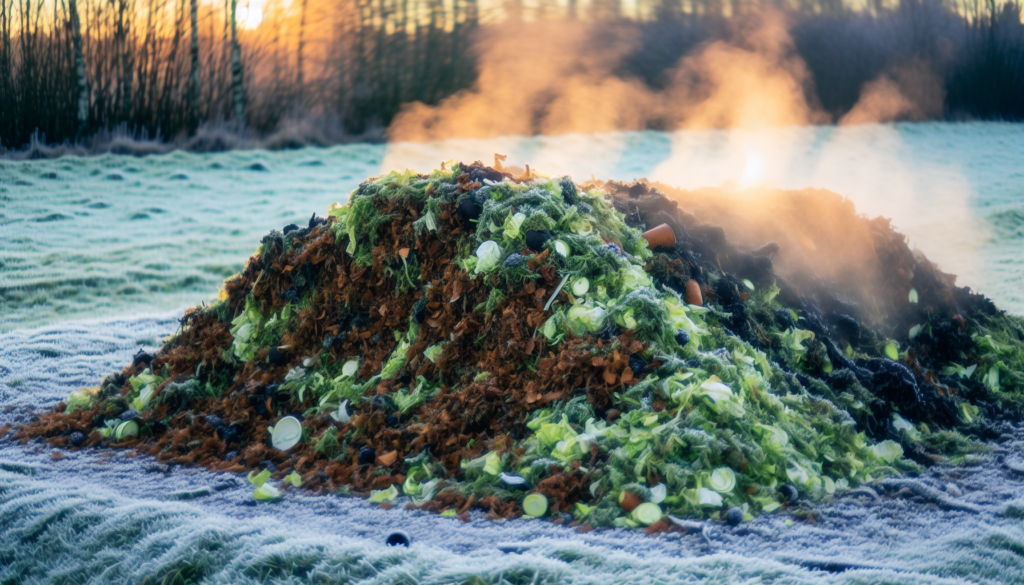
With the essentials of winter composting understood, it’s time to prepare your outdoor compost pile for the cold. This process, also known as winterizing your compost pile, adds fresh spring nutrients to your garden and is a crucial step as you transition into a colder climate.
From cold composting and sheet mulching, to maintaining regular compost bin and piles of different ages, there are various methods to expedite the composting process and enhance the quality of the finished compost.
Before discussing these methods, let’s first understand the importance of building a large compost pile, adjusting composting habits before winter, and protecting the pile from winter conditions.
Building a Large Compost Pile to Generate Enough Heat
Size matters when it comes to composting in winter. A large compost pile or bin is crucial for sustaining microbial activity and generating the necessary internal heat to continue decomposing materials even during winter. For hot composting in winter, your pile size should ideally be at least 3 feet x 3 feet x 3 feet – a dimension that allows temperatures to reach around 150 to 175 degrees Fahrenheit for a short period of time.
Wondering about the reason for this size? Well, a pile measuring at least 3 feet by 3 feet ensures that it retains heat effectively and minimizes the risk of freezing too quickly in cold weather.
Adjusting Composting Habits Before Winter Arrives
As winter approaches, your composting habits need to change. For instance, it’s a good idea to stay warm and to add a foot of browns, such as straw or dead leaves, to the bottom of your compost bin. This aids the composting process as temperatures drop. Also, avoid turning the compost pile during winter to prevent heat loss and further slowing of the decomposition process.
Additionally, consider chopping your green and brown materials into smaller pieces before winter. This increases their surface area, speeding up decomposition and heat generation. However, be cautious about adding large amounts of wood ash to your compost pile in winter. This can raise the pH above the optimum range, decreasing microbial activity and slowing down decomposition.
Shielding Your Pile from Winter Elements
Protecting your compost pile from the harsh winter elements is equally important. Black tarps can be useful for this. They absorb heat and help heat up the compost pile underneath, while also adding a layer of protection from the cold. Tarps not only retain heat but also protect an open compost pile from becoming too soggy during the winter months, which is crucial in areas with a lot of rain or snow.
Another option is to use a sealed compost tumbler, which offers a more controlled environment by preventing excess moisture from rain and snowmelt.
So, don’t let the winter elements deter you. With the right shielding, you can successfully start composting throughout winter.
Indoor and Alternative Composting Methods

Not everyone has the luxury of an outdoor space for composting, especially in winter. Fortunately, there are indoor and alternative composting methods you can explore. From vermicomposting and bokashi fermentation to countertop composting, there’s no shortage of innovative solutions for winter composting indoors.
We will further examine these methods.
Vermicomposting: A Good Alternative for the Frozen Months
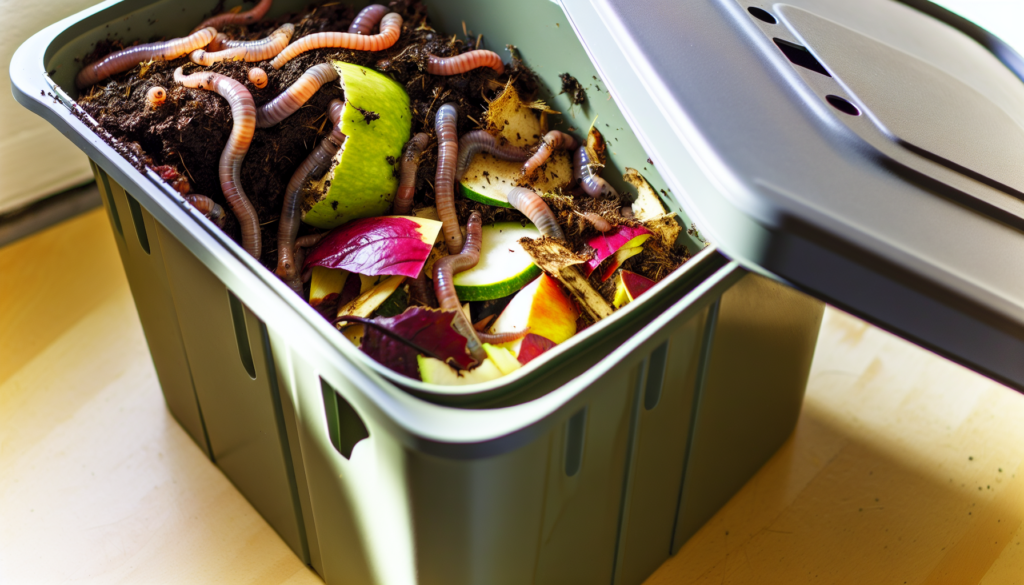
Worm composting, also known as vermicomposting, is an indoor composting method that uses worms to break down the organic matter and waste into nutrient-rich compost.
During winter, you can move your worm composting bin to a warmer indoor space such as a basement or an unheated garage. These areas provide consistent temperature and humidity, protecting worms from extreme temperatures.
To sustain the composting process, you can stimulate microbial activity by increasing organic waste and fine-tuning the carbon-to-nitrogen ratio in your worm bin.
You can also use insulation techniques and seed starting mats to provide consistent warmth and preserve favorable temperatures in the worm bin.
Bokashi Fermentation: Kitchen Waste to Pre-Compost

Bokashi composting is another effective method for composting kitchen waste and scraps during winter. It involves using bran for microbial inoculation and fermentation in a bucket. Here’s how it works:
- Place kitchen scraps and egg shells in the bucket.
- Top the scraps with bran.
- Leave the bucket to ferment for 2-4 weeks.
- After fermentation, you will have pre-compost that you can add to a compost pile or bury directly in your garden.
During winter, you can store your bokashi compost in the following ways:
These methods facilitate the storage of winter composting collection during winter, allowing it to be easily moved and emptied into garden beds in the spring.
Countertop Composting Innovations

For those with limited space, countertop composting bins provide a convenient solution for indoor winter composting. These bins allow you to collect and begin composting your food waste and scraps right in your kitchen. A five-gallon food-grade bucket with a lid is one such countertop composting option that is suitable for smaller volumes of food waste and can function well for winter composting indoors.
Another innovative solution is creating a soil factory indoors. This involves storing compost in large plastic boxes layered with leaves or old potting soil, providing an effective way to manage organic waste inside your home.
With these countertop composting innovations, you can continue composting throughout winter, regardless of your living situation.
Maintaining Your Winter Compost Pile
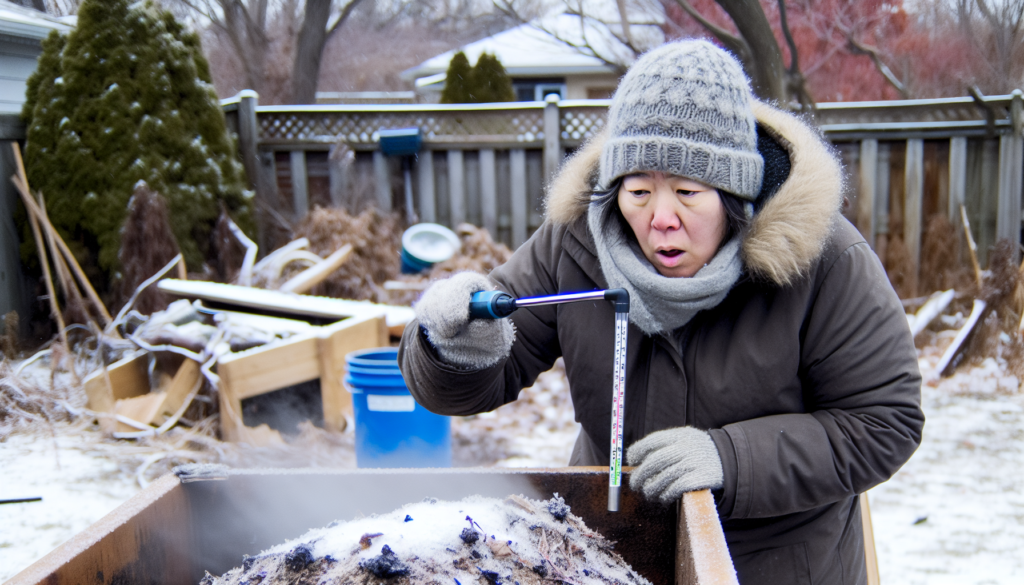
Keeping your winter compost pile active and healthy requires regular maintenance. From monitoring temperature and aeration to adding scraps throughout winter and knowing when to turn the pile, there’s a lot to consider.
We’ll further explore these considerations for a deeper understanding.
Monitoring Temperature and Aeration
One of the key aspects of maintaining your winter compost pile is monitoring its temperature and aeration. The optimal temperature range for winter composting is between 135°F and 165°F, which ensures rapid decomposition without harming the beneficial microorganisms.
You can increase the compost pile’s surface area and speed up decomposition by reducing the size of compost materials through cutting, chopping, or shredding.
Strategic aeration, too, plays a crucial role in maintaining a successful winter compost pile. By turning the pile when internal temperatures fall, you can provide necessary oxygen for bacteria, helping restore heat production in the compost pile without causing it to dry out.
However, be sure to maintain even dampness in the compost pile to support optimal decomposition conditions and consistent heat generation.
Adding Scraps Throughout Winter
Continuing to add food scraps back to your compost pile throughout winter is essential. One effective method to manage your kitchen scraps is to use the food scraps freeze technique, which involves storing them in heavy-duty freezer bags to prevent fruit flies and avoid the smell before adding them to the compost bin. Chopping up kitchen scraps finely can also help them decompose more quickly and generate enough heat back, which is crucial for the winter composting process.
It’s also necessary to layer greens with browns throughout the cold season. This prevents the pile from becoming a wet and odorous mess by the time of the spring thaw.
When to Turn the Pile
Turning the compost pile is a crucial aspect of compost maintenance. However, during winter, it’s often better to minimize turning the compost pile to conserve heat. If the temperature of the compost pile drops significantly, turning the pile along with adding nitrogen-rich materials can stimulate microbial activity, leading to an increase in temperature.
However, turning the compost pile should not be too frequent to avoid disruption of the composting process. Sufficient turning is necessary to prevent anaerobic conditions and maintain oxygen levels for efficient decomposition. So, turn the pile cautiously during winter, only when necessary to reenergize the pile and maintain oxygen levels.
Troubleshooting Common Winter Composting Issues
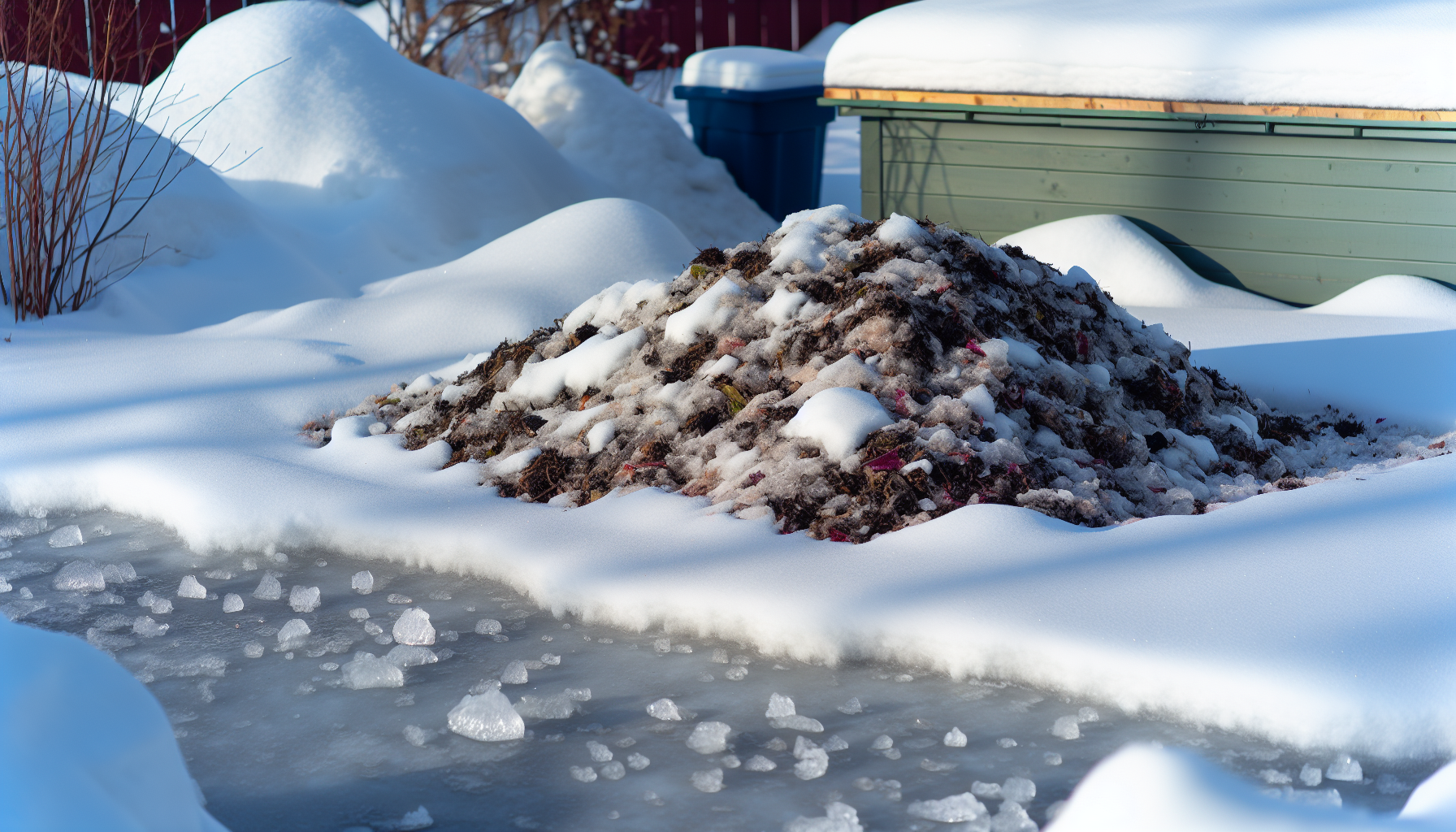
Just like any other process, winter composting comes with its own set of challenges. From dealing with a frozen compost pile and balancing the green-to-brown ratio to overcoming challenges posed by snow and ice, you might encounter a few hiccups along the way. But fear not! We’re here to help you troubleshoot these common winter composting issues.
Dealing with a Frozen Compost Pile
Finding your compost pile frozen solid can be disheartening. But don’t worry, it’s not the end of the world. To revive a frozen compost pile, you can use a thick layer of straw or shredded grass clippings as insulation. Cover this insulating layer with a heavy-duty black tarp, which helps retain moisture and heat because it absorbs sunlight and prevents saturation from snow or rain.
To prevent heat loss, it’s advisable not to turn the compost pile during winter. Wait to turn it until spring when it has completely thawed.
With these measures, your frozen compost pile will be back on track in no time.
Balancing the Green-to-Brown Ratio
A balanced green-to-brown ratio is vital for a healthy compost pile. A balanced mix of green and brown materials used, with roughly 50% green materials (high-nitrogen) and 50% more browns (carbon-rich) materials, helps avoid issues like odor and pests. Keep in mind, a healthy compost pile relies more on the right green-to-brown ratio than achieving the exact carbon-to-nitrogen (C:N) ratio.
However, during winter, be cautious about adding large amounts of wood ashes to your compost pile. This can significantly raise the pH level, which may harm microbial activity and slow down decomposition.
So, keep an eye on that green-to-brown ratio and make adjustments as necessary to keep your compost pile healthy and active all winter long after.
Overcoming Challenges Posed by Snow and Ice
Finally, we’ll address the challenges brought by snow and ice. While these winter elements can be difficult to deal with, they’re not insurmountable. A thick layer of straw or shredded grass clippings, which may contain weed seeds, can be used as insulation to revive a frozen pile or compost pile. Covering this insulating layer with a heavy-duty black tarp can also help retain moisture and heat.
Additionally, avoid turning the compost pile during winter to conserve heat. Wait to turn it until spring, when it has completely thawed. With these measures, you can overcome for few months the challenges posed by snow and ice and maintain a successful winter compost pile.
Summary
Whether you’re a seasoned gardener or a composting newbie, winter composting is a practical and sustainable way to reduce household waste and produce valuable soil amendments. From selecting the right location and materials for your compost bin to managing moisture and insulation, building a large compost pile, adjusting composting habits, and exploring indoor and alternative composting methods, there’s a lot to consider. But with the right knowledge and a little effort, you can successfully compost throughout winter and have a ready supply of compost for your spring garden preparation.
Frequently Asked Questions
